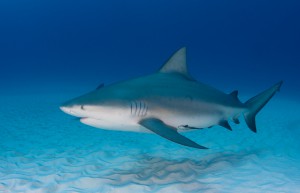Most of us remember the string of shark attacks that occurred this past summer in North Carolina; as a matter of fact, according to the International Shark Attack File, it was a record year for that region. Since 2001 there have been 34 shark attacks in North Carolina ranging from 1-5 per year (average 2.4 attacks / year); this year there were 8 attacks. Why the increase?
Reviewing the trend data we can see that the human population has increased, attendance at local beaches has increased, the number of tourists to our beaches has increased, and the shark attacks have also increased. But could the actual number of sharks be increasing as well? A recent report suggest… maybe.

Pregnant Bull Shark (Carcharhinus leucas) cruses sandy seafloor. Credit Florida Sea Grant Stock Photo
Since 1986 NOAA’s Northeast Fisheries Science Center has been capturing and logging sharks along the southeast coast of the United States. This year’s survey logged 2,835 sharks between North Carolina and Florida; most were Sandbar’s, Atlantic Sharpnose, Dusky, and Tiger sharks. This is an increase from 1,831 in 2012 and higher than any year since the surveys began.
Are they getting better at catching shark? Maybe… but scientific surveys require that the team use the same protocol each year when conducting such surveys, suggesting that there are in fact more sharks out there. If this is so, why are there more sharks?
Well you first have to confirm that this is in fact the case – sharks are in fact increasing. But scientists can begin looking at data that could explain it. Typically you would begin with their food supply and predation. Though we now know that increase in food supply does not always equate to an increase in predators, it is data that should be reviewed. And what about predators of sharks? Which is typically us.
A review of the NOAA shark landing data indicates that 5 of the 9 shark categories have been closed as of June 22, 2015 because they have landed a significant percentage of their allowed quota for the year. This equates to good fishing… which could mean more sharks. Discussing with local divers in the Pensacola area, they believe they are seeing more sharks – and the increase seems to be closer inshore. It is an El Nino year, and environmental conditions change during these seasons. It is known that environmental changes will certainly trigger changes in fishery numbers and distribution.
As the scientific process works itself out, we will learn more about what is occurring with sharks in U.S. waters. In our state the Florida Fish and Wildlife Conservation Commission protects 25 species of sharks. Anglers are allowed one non-protected species and no more than 2 per vessel. (Learn More). More should be known once the 2015 season comes to an end. Why shark numbers in North Carolina have increased is not understood at this time but monitoring will continue.
- Searching for Mangroves in the Florida Panhandle - April 6, 2024
- The Swallow-tailed Kites are Back - March 30, 2024
- Beach Wildlife Walk – Late Winter - March 22, 2024
